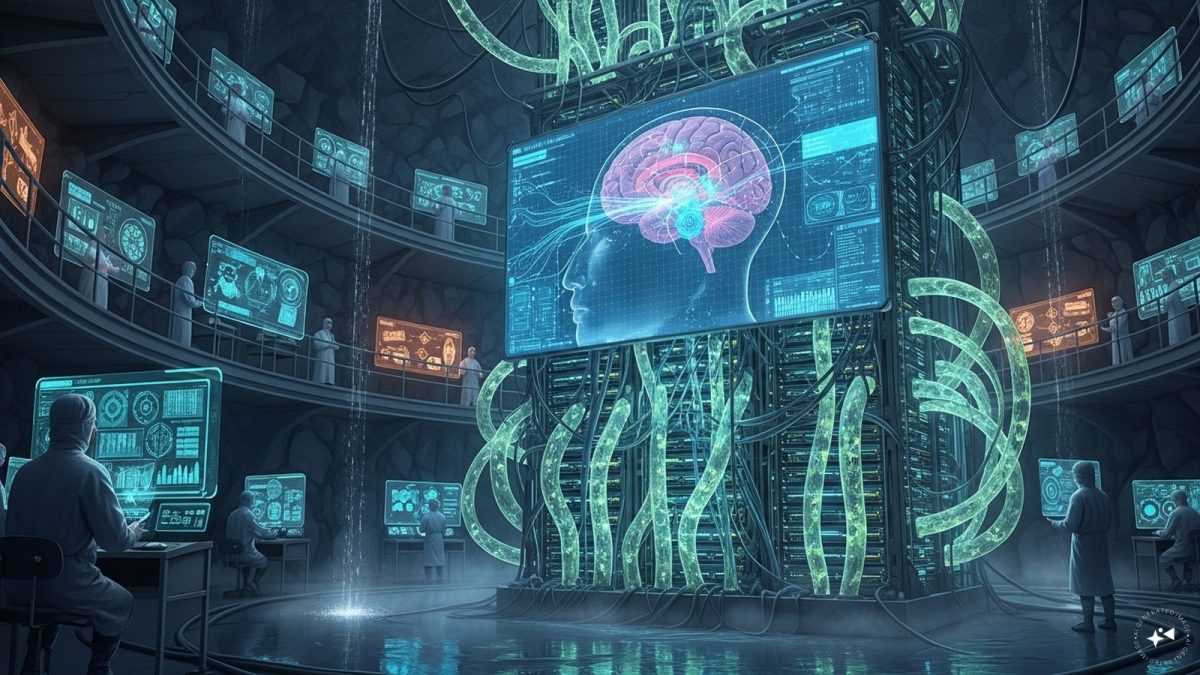Last Updated:October 05, 2025, 13:57 IST
The mini-brains are not conscious; they are simplified sandboxes of the human mind, far smaller than the brain’s 86 billion neurons.
The human brain is a marvel of efficiency, with 86 billion neurons running on just 20 watts. (Representative image: AI-generated)
One of the most exciting emerging fields of 21st-century science is biocomputing, a concept that almost feels straight out of science fiction. In simple terms, biocomputing is the study of using biological systems to perform computing functions. Instead of traditional silicon-based chips, cells or mini brain–like tissues carry out computational tasks.
Swiss software company FinalSpark is developing “living” servers that replicate how artificial intelligence (AI) learns. According to the BBC, these servers could one day rival traditional data centres while using only a fraction of the energy.
From researchers at Johns Hopkins University to scientists at FinalSpark Labs, multiple teams are exploring biocomputing to create mini human brains. While their approaches vary, the long-term goal is clear: develop hybrid bio-AI systems that combine the natural learning power of the human brain with AI’s adaptive algorithms. Such systems could lead to energy-efficient, brain-inspired intelligence with applications spanning software, medicine, and more.
Although biocomputing is still in its early stages, it’s worth understanding the basics—how scientists create a mini human brain from tiny living cells—before this futuristic technology becomes as common as AI today.
How Tiny Cells Are Turned Into Mini Brains?
At the core of biocomputing are brain organoids—tiny, three-dimensional clusters of human neurons grown from stem cells. These aren’t full brains but simplified models that self-organise into structures mimicking key aspects of the human cerebral cortex, complete with synaptic connections and basic neural circuits.
Derived from induced pluripotent stem cells (iPSCs)—reprogrammed from ordinary skin or blood cells—organoids are cultured in nutrient-rich gels, where they develop over weeks or months into dense networks of up to 800,000 cells.
Researchers at institutions like Johns Hopkins University and Imperial College London start with ethically sourced stem cells, often from clinics in Japan, and guide them into neuron clusters using precise chemical signals that mimic embryonic brain development.
Unlike flat 2D cell cultures, organoids form 3D architectures, enabling realistic interactions among neurons, glia (support cells), and even blood vessel-like structures in advanced models. Though avascular (lacking a full blood supply), innovations like microfluidic perfusion systems keep them alive and responsive for months.
How Do These Mini-Brains Work?
These mini-brains are not conscious; they are simplified sandboxes of the human mind, far smaller than the brain’s 86 billion neurons. Yet their biological authenticity makes them perfect for studying how real brains learn and compute.
The interface is key. High-density microelectrode array (MEAs)—a chip with electrodes that stimulate and record electrical activity.
deliver electrical or chemical stimuli to organoids while recording their spiking activity—bursts of voltage resembling neural “thoughts.” AI algorithms, often reservoir computing models, treat the organoid as a dynamic reservoir, processing chaotic inputs into useful outputs via biofeedback loops.
Why Researchers Are Developing Mini Brains?
The human brain is a marvel of efficiency, with 86 billion neurons running on just 20 watts—a feat modern silicon computers can’t match. As Stanford’s Professor Kwabena Boahen points out, duplicating this performance with conventional chips would need a staggering 10 megawatts, enough to power a small town.
This enormous energy gap is pushing researchers toward biocomputing, using brain organoids—tiny lab-grown clusters of human neurons, or “mini brains.” These living systems could revolutionise computing, harnessing the brain’s natural efficiency and adaptability to create a sustainable alternative to energy-hungry AI.
According to Stanford University Professor Kwabena Boahen, cited by FinalSpark, the human brain is a powerhouse, with 86 billion neurons operating on just 20 watts of energy—a level of efficiency far beyond silicon-based computers. Replicating this performance with conventional chips would demand a staggering 10 megawatts of power.
While AI running on silicon processors consumes massive energy to perform computations, bioprocessors harness the natural energy of living cells, bypassing these power limitations and enabling efficient, brain-like computing.
By integrating these cells with silicon hardware through brain-machine interfaces, researchers aim to create hybrid systems that combine biology’s low-power adaptability with the precision of digital computing.
Companies like FinalSpark (Switzerland) and Cortical Labs (Australia) are racing to scale this up, envisioning “living” data centres where organoids tackle tasks like pattern recognition or decision-making under uncertainty, areas where AI struggles.
The US National Science Foundation (NSF) is fueling progress with USD 14 million in grants to universities such as Harvard and MIT, aiming to engineer organoids for neuromorphic computing—systems that mimic brain-like adaptability while embedding ethical safeguards from the start.
The Experiments With Minibrains
No biocomputing story is complete without DishBrain, the 2022 experiment that captured global attention. Researchers at Monash University (Australia) grew 800,000 human and mouse neurons on a MEA. Connected to a virtual game of Pong, the neurons received “sensory” inputs indicating the ball’s position. They fired signals to “move” a virtual paddle, learning through trial-and-error in a closed-loop system. Within minutes, the organoid adapted, hitting the ball with increasing accuracy—an emergent behaviour guided by the free-energy principle of brain function.
Building on this, Cortical Labs’ CL1—launched in 2025 as the world’s first commercial biocomputer—integrates similar neuron-chips into a rack-mountable device. Users can deploy code to teach the cells tasks like speech recognition or even Bitcoin mining.
Other milestones include Brainoware (2023) from Johns Hopkins, where organoids classified speech patterns, outperforming some AI models on noisy data.
How Will Bicomputing Impact Our Lives?
Biocomputing’s appeal lies in its applications. In medicine, organoids model diseases like Alzheimer’s or epilepsy, enabling drug testing on human-like neural networks without animal trials.
The CL1, for instance, has restored learning in epileptic neuron cultures using antiepileptics, hinting at personalised therapies. NSF-funded projects at UC Irvine even aim to connect organoids to prosthetics for motor control restoration.
For computing, organoid intelligence promises energy-efficient AI alternatives. Mini brains could handle heterogeneous data for climate modelling, autonomous drones, or other tasks, learning continuously without retraining. FinalSpark envisions biocomputers slashing data centre emissions, while Cortical’s cloud service allows remote experimentation.
Organoid intelligence could produce hybrid supercomputers by 2030, blending wetware with silicon to tackle tasks beyond AI’s current reach. Advances in CRISPR editing and vascularisation may yield smarter organoids, while global collaborations address ethical concerns. Cortical Labs plans neuron counts in the billions, aiming for human-level adaptability.
The Tough Road Ahead For Biocomputing
Biocomputing faces two major hurdles: one technical, the other ethical.
On the technical side, brain organoids are living cells, not silicon chips. While chips only need electricity, these mini-brains rely on nutrients delivered by blood vessels in a real brain. But organoids are avascular—lacking a vascular system—which means their cells often starve and die before they can grow to a larger, scalable size.
According to a BBC report, FinalSpark has made progress: its organoids can now survive up to four months. Still, their short lifespan makes scaling mini-brains a major challenge.
The ethical concerns run even deeper. What if organoids begin to exhibit consciousness or replicate aspects of human cognition? As highlighted in Frontiers, advances in organoid intelligence (OI) could trigger the Greely Dilemma—where the very success of modelling human brain processes raises the same moral questions that inspired the research in the first place. If organoids start mimicking learning and cognition, society will need to ask: do they have moral status, and what obligations do we have toward their welfare?
Scientists are already preparing for this. NSF-funded projects mandate strict bioethics frameworks, from public input to privacy protections for stem cell donors. For now, experts agree that organoids lack consciousness—but as the field advances, constant vigilance will be essential.
Surbhi Pathak, subeditor, writes on India, world affairs, science, and education. She is currently dabbling with lifestyle content. Follow her on X: @S_Pathak_11.
Surbhi Pathak, subeditor, writes on India, world affairs, science, and education. She is currently dabbling with lifestyle content. Follow her on X: @S_Pathak_11.
First Published:
October 05, 2025, 13:49 IST
News explainers Mini Human Brains Powering Computers? Inside The Sci-Fi World Of BiocomputingDisclaimer: Comments reflect users’ views, not News18’s. Please keep discussions respectful and constructive. Abusive, defamatory, or illegal comments will be removed. News18 may disable any comment at its discretion. By posting, you agree to our Terms of Use and Privacy Policy.
From researchers at Johns Hopkins University to scientists at FinalSpark Labs, multiple teams are exploring biocomputing to create mini human brains. While their approaches vary, the long-term goal is clear: develop hybrid bio-AI systems that combine the natural learning power of the human brain with AI’s adaptive algorithms. Such systems could lead to energy-efficient, brain-inspired intelligence with applications spanning software, medicine, and more.
Although biocomputing is still in its early stages, it’s worth understanding the basics—how scientists create a mini human brain from tiny living cells—before this futuristic technology becomes as common as AI today.
How Tiny Cells Are Turned Into Mini Brains?
At the core of biocomputing are brain organoids—tiny, three-dimensional clusters of human neurons grown from stem cells. These aren’t full brains but simplified models that self-organise into structures mimicking key aspects of the human cerebral cortex, complete with synaptic connections and basic neural circuits.
Derived from induced pluripotent stem cells (iPSCs)—reprogrammed from ordinary skin or blood cells—organoids are cultured in nutrient-rich gels, where they develop over weeks or months into dense networks of up to 800,000 cells.
Researchers at institutions like Johns Hopkins University and Imperial College London start with ethically sourced stem cells, often from clinics in Japan, and guide them into neuron clusters using precise chemical signals that mimic embryonic brain development.
Unlike flat 2D cell cultures, organoids form 3D architectures, enabling realistic interactions among neurons, glia (support cells), and even blood vessel-like structures in advanced models. Though avascular (lacking a full blood supply), innovations like microfluidic perfusion systems keep them alive and responsive for months.
How Do These Mini-Brains Work?
These mini-brains are not conscious; they are simplified sandboxes of the human mind, far smaller than the brain’s 86 billion neurons. Yet their biological authenticity makes them perfect for studying how real brains learn and compute.
The interface is key. High-density microelectrode array (MEAs)—a chip with electrodes that stimulate and record electrical activity.
deliver electrical or chemical stimuli to organoids while recording their spiking activity—bursts of voltage resembling neural “thoughts.” AI algorithms, often reservoir computing models, treat the organoid as a dynamic reservoir, processing chaotic inputs into useful outputs via biofeedback loops.
Why Researchers Are Developing Mini Brains?
The human brain is a marvel of efficiency, with 86 billion neurons running on just 20 watts—a feat modern silicon computers can’t match. As Stanford’s Professor Kwabena Boahen points out, duplicating this performance with conventional chips would need a staggering 10 megawatts, enough to power a small town.
This enormous energy gap is pushing researchers toward biocomputing, using brain organoids—tiny lab-grown clusters of human neurons, or “mini brains.” These living systems could revolutionise computing, harnessing the brain’s natural efficiency and adaptability to create a sustainable alternative to energy-hungry AI.
According to Stanford University Professor Kwabena Boahen, cited by FinalSpark, the human brain is a powerhouse, with 86 billion neurons operating on just 20 watts of energy—a level of efficiency far beyond silicon-based computers. Replicating this performance with conventional chips would demand a staggering 10 megawatts of power.
While AI running on silicon processors consumes massive energy to perform computations, bioprocessors harness the natural energy of living cells, bypassing these power limitations and enabling efficient, brain-like computing.
By integrating these cells with silicon hardware through brain-machine interfaces, researchers aim to create hybrid systems that combine biology’s low-power adaptability with the precision of digital computing.
Companies like FinalSpark (Switzerland) and Cortical Labs (Australia) are racing to scale this up, envisioning “living” data centres where organoids tackle tasks like pattern recognition or decision-making under uncertainty, areas where AI struggles.
The US National Science Foundation (NSF) is fueling progress with USD 14 million in grants to universities such as Harvard and MIT, aiming to engineer organoids for neuromorphic computing—systems that mimic brain-like adaptability while embedding ethical safeguards from the start.
The Experiments With Minibrains
No biocomputing story is complete without DishBrain, the 2022 experiment that captured global attention. Researchers at Monash University (Australia) grew 800,000 human and mouse neurons on a MEA. Connected to a virtual game of Pong, the neurons received “sensory” inputs indicating the ball’s position. They fired signals to “move” a virtual paddle, learning through trial-and-error in a closed-loop system. Within minutes, the organoid adapted, hitting the ball with increasing accuracy—an emergent behaviour guided by the free-energy principle of brain function.
Building on this, Cortical Labs’ CL1—launched in 2025 as the world’s first commercial biocomputer—integrates similar neuron-chips into a rack-mountable device. Users can deploy code to teach the cells tasks like speech recognition or even Bitcoin mining.
Other milestones include Brainoware (2023) from Johns Hopkins, where organoids classified speech patterns, outperforming some AI models on noisy data.
How Will Bicomputing Impact Our Lives?
Biocomputing’s appeal lies in its applications. In medicine, organoids model diseases like Alzheimer’s or epilepsy, enabling drug testing on human-like neural networks without animal trials.
The CL1, for instance, has restored learning in epileptic neuron cultures using antiepileptics, hinting at personalised therapies. NSF-funded projects at UC Irvine even aim to connect organoids to prosthetics for motor control restoration.
For computing, organoid intelligence promises energy-efficient AI alternatives. Mini brains could handle heterogeneous data for climate modelling, autonomous drones, or other tasks, learning continuously without retraining. FinalSpark envisions biocomputers slashing data centre emissions, while Cortical’s cloud service allows remote experimentation.
Organoid intelligence could produce hybrid supercomputers by 2030, blending wetware with silicon to tackle tasks beyond AI’s current reach. Advances in CRISPR editing and vascularisation may yield smarter organoids, while global collaborations address ethical concerns. Cortical Labs plans neuron counts in the billions, aiming for human-level adaptability.
The Tough Road Ahead For Biocomputing
Biocomputing faces two major hurdles: one technical, the other ethical.
On the technical side, brain organoids are living cells, not silicon chips. While chips only need electricity, these mini-brains rely on nutrients delivered by blood vessels in a real brain. But organoids are avascular—lacking a vascular system—which means their cells often starve and die before they can grow to a larger, scalable size.
According to a BBC report, FinalSpark has made progress: its organoids can now survive up to four months. Still, their short lifespan makes scaling mini-brains a major challenge.
The ethical concerns run even deeper. What if organoids begin to exhibit consciousness or replicate aspects of human cognition? As highlighted in Frontiers, advances in organoid intelligence (OI) could trigger the Greely Dilemma—where the very success of modelling human brain processes raises the same moral questions that inspired the research in the first place. If organoids start mimicking learning and cognition, society will need to ask: do they have moral status, and what obligations do we have toward their welfare?
Scientists are already preparing for this. NSF-funded projects mandate strict bioethics frameworks, from public input to privacy protections for stem cell donors. For now, experts agree that organoids lack consciousness—but as the field advances, constant vigilance will be essential.
Stay Ahead, Read Faster
Scan the QR code to download the News18 app and enjoy a seamless news experience anytime, anywhere.


